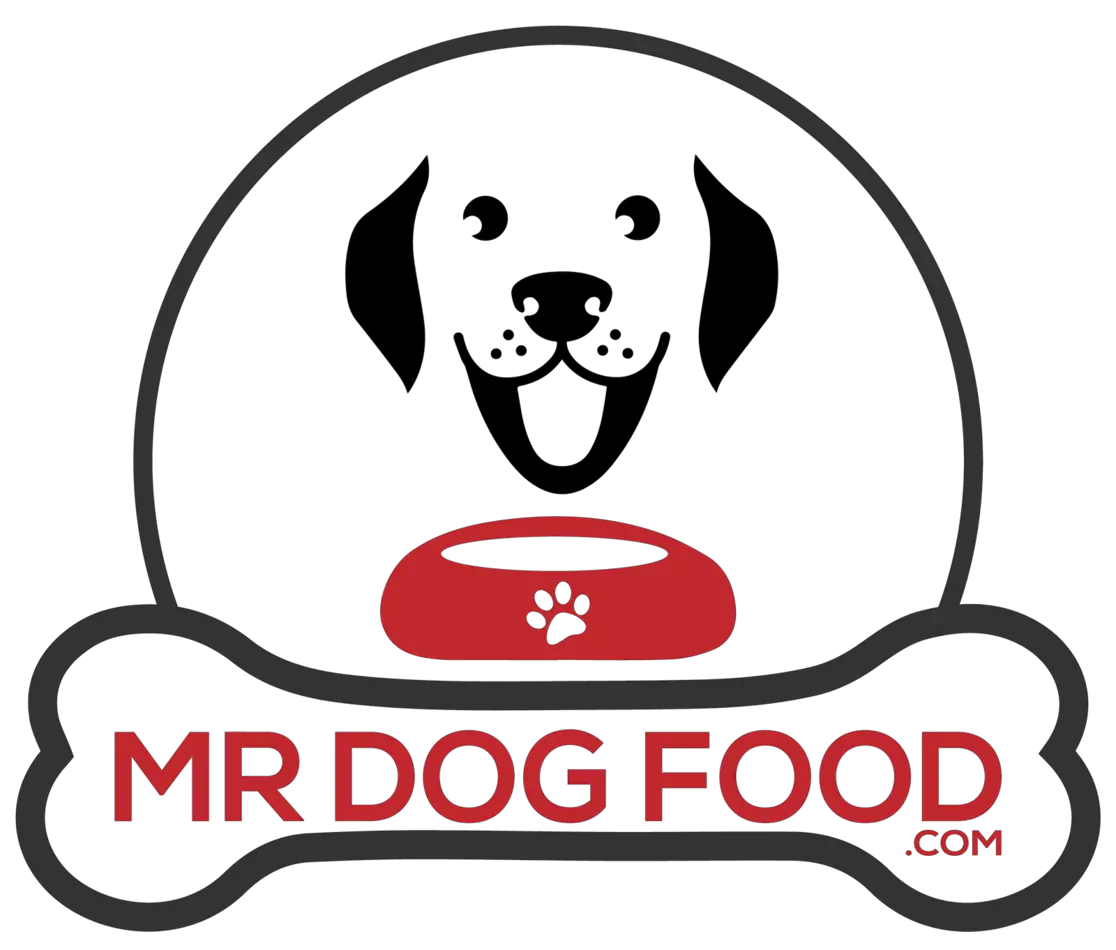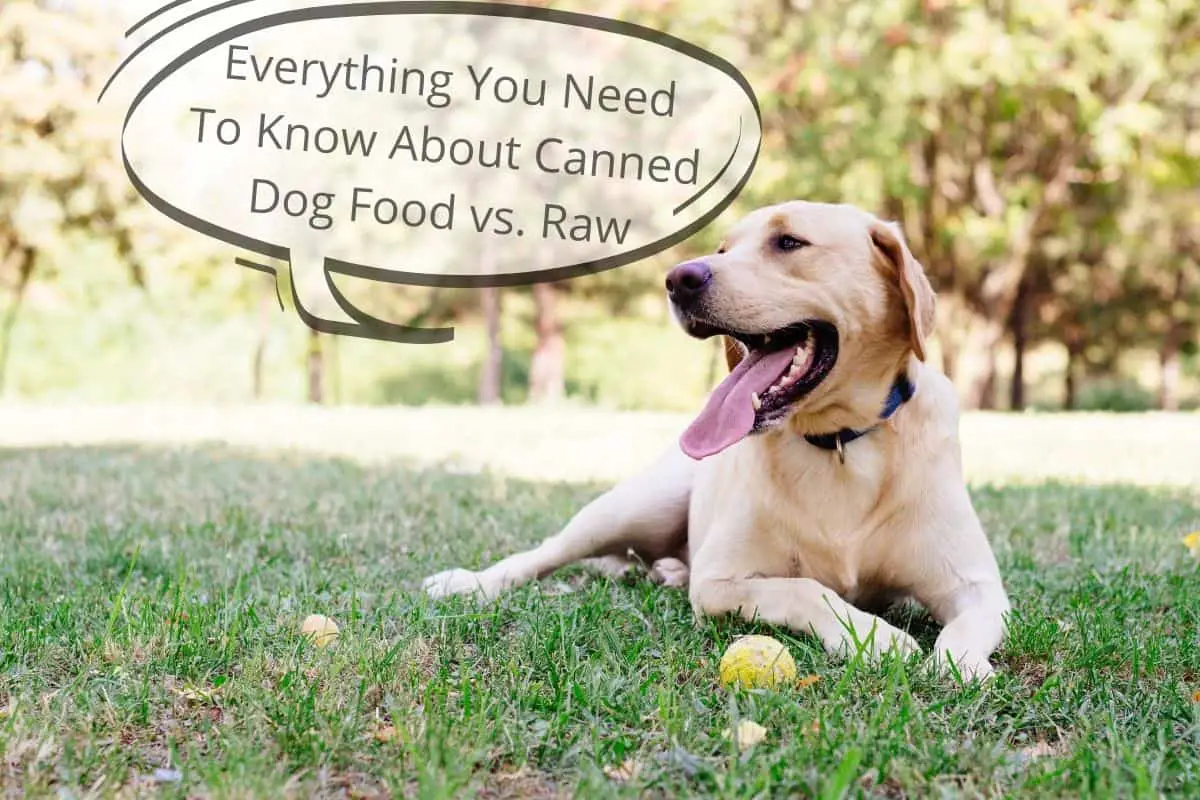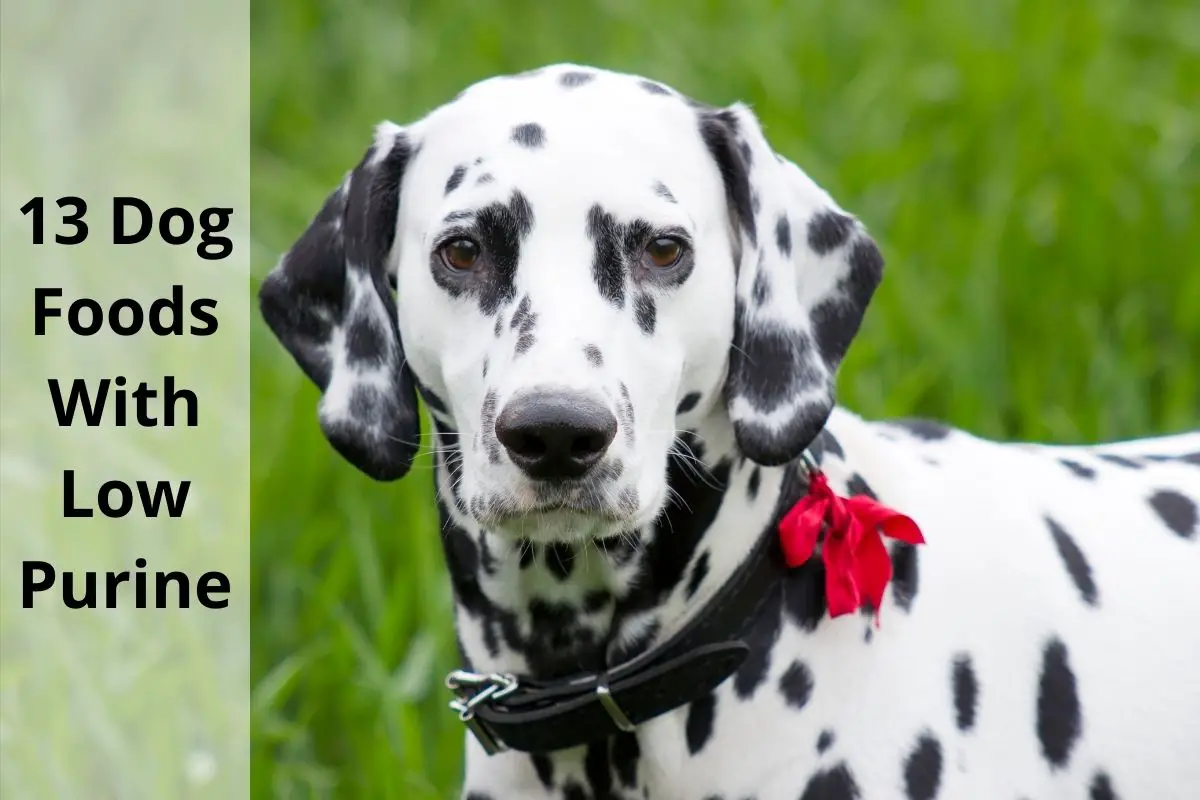This post contains affiliate links.
Taking care of your furry companion can be an emotionally fulfilling task. But if you want your beloved pooch to live a long life, then you need to pay attention to what you feed them and know everything you need to know about canned dog food vs. raw food!
Canned food comes in airtight containers, meaning that you can preserve food longer. On the other hand, raw food can quickly rot if left exposed at room temperature for a prolonged time. Yet, it provides more protein and bacteria, which are helpful to your dog’s digestive tract and growth.
So, if you’re on the fence contemplating between the two pet dietary options, stick around. We’ll discuss everything you need to know about canned versus raw dog food and how to decide on the best choice for your adorable pet.
Canned vs. Raw Food: What’s the Difference?
Besides their overall physical distinguishing features, canned food comes bundled with preservatives in a container. In contrast, raw food is harvested straight from the animal in its purest and uncooked state, with each meal choice featuring its distinct benefits.
Let’s discuss the nutritional content and feeding practices of the two diets, the pros and cons, and which dogs are most suited for each dietary plan.
Canned Dog Food
Canned dog foods are arguably one of the easiest food sources that you can obtain. Besides being available at your local supermarket or pet store, they provide great nutritional value with each can. Their flavors tend to be more palatable to a dog’s tastes and customized to please your dog’s taste buds.
Options range from primary meaty flavors such as beef, chicken, lamb, duck, and fish to complex aromas, featuring herbs, vegetables, and spices that are all easy on the digestive system. Furthermore, canned dog foods are now available in BPA-free packaging options, like tetra paks and pouches, giving dog owners an environmentally friendly alternative to metal cans.
Benefits of Canned Dog Food
Optimal Protein Value and Low Fat than Dry Dog Foods
Canned foods provide a boatload of essential proteins and low-fat content that regular kibble or raw products don’t. That means that you can easily monitor your dog’s protein intake with each meal. That way, you can ensure your puppy gets the required peptides they need for cellular growth, repair, and bone development.
Keeps Your Dog Well Hydrated and Full
Canned dog food contains roughly 80% more moisture content than you’d find in your average kibble or raw food diet. The excess moisture doubles up as a water source to help digestion by flushing away waste while keeping your dog hydrated and full.
Smoother Texture
Canned food is usually softer and more tangible than dry and hard kibble chunks. You can switch between various textures — such as stew, flaked, or shredded formula — to appease their appetite for particularly fussy eaters. More so, it’s easier for younger pups to chew and swallow, as you don’t have to worry about choking hazards or abrasions that happen while chewing.
Palatable and Tasty
The wet texture of canned foods makes them much more aromatic and tastier when the ingredients and spices soak in the moisture, thus emitting rich and robust flavors. Furthermore, canned foods comprise higher protein content than carbs, meaning your pooch gets to savor the taste of original meat without the artificial flavorings and colors of regular dry foods.
More Variety
Canned foods allow dog owners to choose various flavors and tastes, depending on their dog’s preferences. This makes canned foods quite popular because you can switch the flavors if your dog likes a little variety in his bowl or gets bored of beef stew every day!
Promotes Weight Loss in Dogs
The high moisture content in canned foods can help maintain your dog’s overall health level by making them feel full faster. As a result, your dog won’t eat excess calories or gain weight, nor will your pup feel starved. Also, the ingredients in pure canned foods facilitate muscle growth, which can help lessen body fat while keeping your canine lean and healthy.
Reduces Bloat Symptoms
Canned foods help alleviate bloat by reducing air ingestion while your dog chews. The diet’s liquid nature allows foods to channel down the throat without causing your dog to gulp and store excess air in the stomach, causing bloat.
Therefore, if your dog is prone to bloat, consider switching their diet to alleviate bloat symptoms, like:
- Unsuccessful belches and vomit attempts
- Excessive salivation
- Pale looking gums
- Breath shortness
- Swollen stomach
- Signs of weakness
It Prevents Organ and Kidney Stress
Dogs need sufficient water to stay hydrated each day. Their intake needs are met with canned foods, keeping them quenched, thus reducing the strain on their vital organs when dehydrated. It can also prevent kidney damage in the long term.
Cons of Canned Dog Food
Metal Cans Could Contain Toxins
Typically, metal cans contain Bisphenol A (BPA), an industrial endocrine-disrupting chemical that can cause adverse effects in pets and animals, like increased blood pressure, neurological problems, and hormonal imbalances. Compared to dry foods, BPA levels increase by nearly threefold in dogs that consume canned foods.
Loose Stool
The chemicals in canned foods can affect the firmness of your dog’s bowel movement. Besides making cleaning difficult, the loose stool can cause your dog to become dehydrated quicker, causing discomfort and health concerns.
Is Canned Food Bad for Your Dog’s Teeth?
While wet foods can increase the chances of foul breath and plaque build-up, the soft nature of canned foods presents no threat to your dog’s teeth. They’re not sharp, so they won’t cause cuts or scrapes while chewing. They’re a great starter food for younger puppies or old dogs with dental issues where chewing is painful.
How To Feed Your Dog Canned Foods?
Canned foods are one of the simplest meals you could ever serve your dog, mainly because you won’t have to worry about bones and large chunks, which are choking hazards. Also, canned foods come with preservatives. That means the bad bacteria count is relatively low.
You can instantly fill your dog’s bowl with a can of quality beef without health concerns, like salmonella poisoning. For new pet owners looking for quality canned products, we recommend Purina ONE Grain with Beef & Wild Caught Salmon from Amazon.
The product features rich omega fatty acids, which help boost your dog’s overall skin health. At the same time, the all-in-one antioxidant feature encourages the development of a healthy immune system, protecting your pooch against autoimmune diseases.
Raw Dog Food
Raw foods are anything uncooked. That said, it’s a common misconception that raw foods only include meat. In fact, a raw food diet for dogs and puppies may include bones, liver, chewy tendons, fruits, and vegetables.
In essence, feeding a domesticated dog raw food can be a challenge. However, with time, their carnivorous side will emerge. So, before thinking about tossing your dog a lump of raw steak and calling it a night, here’s everything you need to know about raw feeding, the benefits, and why you should consider uncooked dietary choices:
Benefits of Raw
- Alleviates junk and synthesized chemicals – Raw foods do without the heavily processed chemicals, salts, and sugars of canned and kibble diets. This makes it more manageable for dog owners to control their pet’s health and nutritional intake.
- Less waste – With raw diets, there’s less digestive waste, as all the essential minerals and nutrients break down in the digestive tract. As a result, your pet’s bowel movements improve, producing biodegradable stool without any pungent odors.
- Better coat and skin health – Feeding your dog raw foods can improve their coat and skin quality due to the presence of concentrated amino and omega fatty acids. These compounds help reduce shedding and enhance fur quality by giving it a smooth and glossy texture.
- Can be freeze-dried – Freeze-dried foods have their moisture removed, making it easier to turn into sizable pellets and patties that you can store for later consumption. So, if you’re worried about rotting meat, you can freeze-dry your raw dog food and feed your pet later.
- Enhanced dental health – Raw meats contain essential enzymes that help combat bacteria that can lead to bad breath, periodontal disease, and gingivitis. That said, it can help reduce plaque formation on the teeth.
Cons of Raw
- Costs – Compared to kibble or canned foods, the price tag on raw diets is enough to send pet owners scampering. On average, 2 pounds (0.91 kg) of raw dog steak fares the same as meat for human consumption. Meaning you’ll spend roughly 1.5 times more than staying with kibble or canned foods.
- Preparation time – Preparing a meal consisting of raw food can require some work. Unlike kibble, which you can feed in one step, pet owners need to take time to defrost and portion raw foods evenly and thoroughly. They also need to prepare kitchen surfaces before cutting meat to reduce bacterial infections.
How To Feed Your Dog Raw Food?
Your dog may already be used to a diet consisting of canned food or kibble. Regardless, making the switch to raw food is possible but requires patience and effort.
At first, your dog may not have a taste for raw food, as years of domestication and treats may have dulled their natural affinity for raw meat. Start by gradually feeding your small dog chunks of raw foods, making sure to remove bones altogether. Alternatively, skip deboning by opting for boneless chicken breast, beef mince, or fillet.
Once your pet is comfortable consuming raw foods, you can up their daily intake and regularly feed him carrots to treat good behavior.
For more guidance on raw feeding, you can refer to this video, which reviews effective raw meat preparation techniques and how to measure proportions:
Is Raw Food Safe?
Many believe that raw diets are dangerous for a dog’s health, especially those in the pet food industry. While salmonella is a rising concern for most pet owners, dogs naturally possess more stomach acid, allowing them to handle bacteria in raw meat effectively. However, you can play your part and mitigate the risk of poisoning by practicing good hygiene, such as washing your hands and surfaces when preparing raw meals for your pet.
Dental Care Practices for Canned Foods vs. Raw
Regular brushing and dental chews are great for reducing harmful bacteria build-up, leading to foul breath and periodontal disease (PD). You can also consider choosing canned foods, including carrots and peas, suitable for improving the pet’s breath.
We recommend sprinkling this Proviable-DC Probiotic on your dog’s food if you go with raw feeding. The product features multiple bacterial strains, supporting intestinal balance and alleviating lousy breath and plaque.
Choosing Between Canned Dog Food vs. Raw Dog Food
It can be overwhelming when deciding whether to stick to canned food or raw diets. One way you can ease the process is to narrow down your options and discover your dog’s preference.
If you have a flexible budget and are more interested in providing optimal nutritional value, you can opt for raw foods. That doesn’t mean that you should necessarily stick to meat. You can also spice up your dog’s palette with some organic carrots, peas, and greens for more fiber and vitamin intake.
On the other hand, if you’re more restricted financially, canned foods can provide a suitable alternative. They’re rich in flavor and can satisfy your dog’s cravings much more effectively. With canned foods, you’re free to experiment and sample different flavors, allowing you to bond with your dog and understand their likings and favorite tastes.
In Summary
Now that you understand the diverse benefits and shortcomings of both canned dog foods and raw, you’ll be able to commit to one diet or the other. Remember to consider your pet’s reaction during the initial stages of their diet transition.
With these tools in your arsenal, you should be confident enough in selecting the correct nutritional options for your dog. Not only will you stand to improve your loving companion’s appetite, but you can also enhance their health to enjoy every joyous occasion together with man’s best friend.
Related Articles
- Daily Canned Dog Food Feeding Quantities (With Examples)
- The Canned Dog Food Versus Dry Dog Food Debate Rages On
- 7 Reasons Why Canned Dog Food Needs To Be Refrigerated
- A Dog Owner’s Guide to Canned Dog Food and Diarrhea
- Canned Dog Food vs. Homemade (Which Is Best?)
Sources
- Pet Assure: The Truth Behind Raw Foods, Kibble and Canned FoodsAbc.net: How To Choose The Right Food For Your Dog
- Pedigree: Which Is Best: Dry Dog Food or Wet Dog Food?
- All About Dog Food: Raw Feeding 101
- Foodpreserving: How canning preserves food
- Homes Alive Pets: Raw Dog Food for Beginners
- Pets WebMD: Raw Dog Food: Dietary Concerns
- PetMD: What Is the Best Dog Food?
- Petplan: The Pros And Cons Of A Raw Food Diet For Dogs
- Homes Alive Pets: 13 Canned Dog Food Benefits
- Homes Alive Pets: Choosing Dog Food: What Does My Dog Need?
- Homes Alive Pets: Types of Dog Food: A Helpful Breakdown
- News Bureau: Bisphenol A in Canned Dog Food May Increase BPA Concentrations in Pets
- NIEHS: Endocrine Disruptors
- Sitting for cause: All Wet or All Dry Diet: Pros and Cons for Your Pet
- Gimmethegoodstuff: Are Tetra Paks Nontoxic and Safe?
- PFMA: Proteins In Pet Food Fact Sheet
Mrdogfood.com is a participant in the Amazon Services LLC Associates Program, an affiliate advertising program designed to provide a means for sites to earn advertising fees by advertising and linking to Amazon.com. We also participate in other affiliate programs which compensate us for referring traffic.





